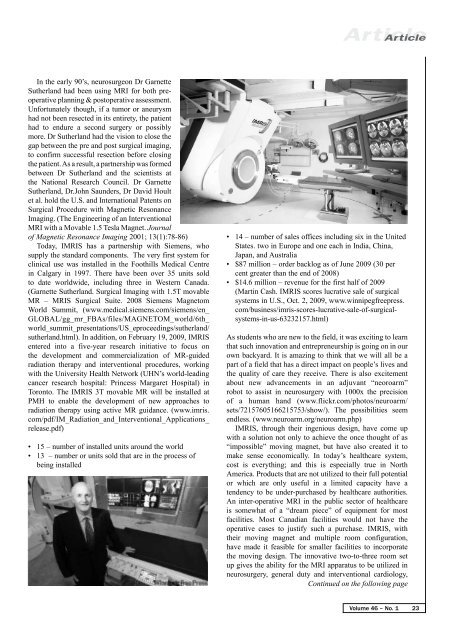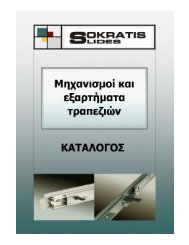isrrt Newsletter Volume 46. No.1 - 2010
Create successful ePaper yourself
Turn your PDF publications into a flip-book with our unique Google optimized e-Paper software.
Article<br />
In the early 90’s, neurosurgeon Dr Garnette<br />
Sutherland had been using MRI for both preoperative<br />
planning & postoperative assessment.<br />
Unfortunately though, if a tumor or aneurysm<br />
had not been resected in its entirety, the patient<br />
had to endure a second surgery or possibly<br />
more. Dr Sutherland had the vision to close the<br />
gap between the pre and post surgical imaging,<br />
to confirm successful resection before closing<br />
the patient. As a result, a partnership was formed<br />
between Dr Sutherland and the scientists at<br />
the National Research Council. Dr Garnette<br />
Sutherland, Dr.John Saunders, Dr David Hoult<br />
et al. hold the U.S. and International Patents on<br />
Surgical Procedure with Magnetic Resonance<br />
Imaging. (The Engineering of an Interventional<br />
MRI with a Movable 1.5 Tesla Magnet. Journal<br />
of Magnetic Resonance Imaging 2001; 13(1):78-86)<br />
Today, IMRIS has a partnership with Siemens, who<br />
supply the standard components. The very first system for<br />
clinical use was installed in the Foothills Medical Centre<br />
in Calgary in 1997. There have been over 35 units sold<br />
to date worldwide, including three in Western Canada.<br />
(Garnette Sutherland. Surgical Imaging with 1.5T movable<br />
MR – MRIS Surgical Suite. 2008 Siemens Magnetom<br />
World Summit, (www.medical.siemens.com/siemens/en_<br />
GLOBAL/gg_mr_FBAs/files/MAGNETOM_world/6th_<br />
world_summit_presentations/US_eproceedings/sutherland/<br />
sutherland.html). In addition, on February 19, 2009, IMRIS<br />
entered into a five-year research initiative to focus on<br />
the development and commercialization of MR-guided<br />
radiation therapy and interventional procedures, working<br />
with the University Health Network (UHN’s world-leading<br />
cancer research hospital: Princess Margaret Hospital) in<br />
Toronto. The IMRIS 3T movable MR will be installed at<br />
PMH to enable the development of new approaches to<br />
radiation therapy using active MR guidance. (www.imris.<br />
com/pdf/IM_Radiation_and_Interventional_Applications_<br />
release.pdf)<br />
• 15 – number of installed units around the world<br />
• 13 – number or units sold that are in the process of<br />
being installed<br />
• 14 – number of sales offices including six in the United<br />
States. two in Europe and one each in India, China,<br />
Japan, and Australia<br />
• $87 million – order backlog as of June 2009 (30 per<br />
cent greater than the end of 2008)<br />
• $14.6 million – revenue for the first half of 2009<br />
(Martin Cash. IMRIS scores lucrative sale of surgical<br />
systems in U.S., Oct. 2, 2009, www.winnipegfreepress.<br />
com/business/imris-scores-lucrative-sale-of-surgicalsystems-in-us-63232157.html)<br />
As students who are new to the field, it was exciting to learn<br />
that such innovation and entrepreneurship is going on in our<br />
own backyard. It is amazing to think that we will all be a<br />
part of a field that has a direct impact on people’s lives and<br />
the quality of care they receive. There is also excitement<br />
about new advancements in an adjuvant “neoroarm”<br />
robot to assist in neurosurgery with 1000x the precision<br />
of a human hand (www.flickr.com/photos/neuroarm/<br />
sets/72157605166215753/show/). The possibilities seem<br />
endless. (www.neuroarm.org/neuroarm.php)<br />
IMRIS, through their ingenious design, have come up<br />
with a solution not only to achieve the once thought of as<br />
“impossible” moving magnet, but have also created it to<br />
make sense economically. In today’s healthcare system,<br />
cost is everything; and this is especially true in North<br />
America. Products that are not utilized to their full potential<br />
or which are only useful in a limited capacity have a<br />
tendency to be under-purchased by healthcare authorities.<br />
An inter-operative MRI in the public sector of healthcare<br />
is somewhat of a “dream piece” of equipment for most<br />
facilities. Most Canadian facilities would not have the<br />
operative cases to justify such a purchase. IMRIS, with<br />
their moving magnet and multiple room configuration,<br />
have made it feasible for smaller facilities to incorporate<br />
the moving design. The innovative two-to-three room set<br />
up gives the ability for the MRI apparatus to be utilized in<br />
neurosurgery, general duty and interventional cardiology,<br />
Continued on the following page<br />
<strong>Volume</strong> 46 – No. 1 23

















